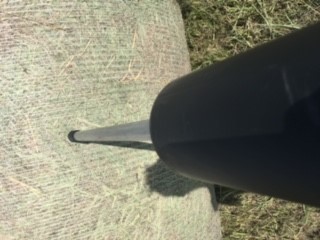
Do’s and don’ts of feeding forages high in nitrate
Acute nitrate toxicity occurs when animals consume high-nitrate forages for a short period of time. Nitrate is converted to nitrite by rumen microbes as an intermediate step in converting the nitrate to microbial protein. Ruminant animals are specifically at risk, as they bring up the feed bolus for chewing and inhale the nitrite.
The nitrite then binds to red blood cells, inhibiting oxygen from binding and resulting in cyanosis and sudden death. In chronic toxicity, low levels of nitrates fed over a longer time stress the animal’s physiological functions, resulting in reduced production performance. Chronic toxicity often results in abortions with no warning signs. So, what should producers do when forage analysis reports high nitrates?
Do raise the cutting height.
Nitrates tend to accumulate in the lower portions of the plant. Therefore, raising the harvest height can help keep nitrate levels low in stored forage.
Do ensile.
Through the ensiling process, microbes convert nitrate to microbial protein. Ensiling forages high in nitrate can reduce the nitrate concentration by up to 50%, but it is not a guarantee. Consequently, it is still important to test ensiled forages for nitrate concentration to mitigate animal health risks and ensure proper dilution for feeding.
Do dilute.
Forages with nitrate levels greater than 2,100 parts per million (ppm) nitrate nitrogen (NO3-N) on a dry basis should be ground and mixed with other forages that are low in nitrate or with high-energy feeds. High-energy feeds can help speed up the microbial process of converting nitrate to microbial protein, thereby decreasing the time nitrite is present in the rumen.
Using high-nitrate forages in a total mixed ration (TMR) requires the forage be chopped and thoroughly mixed at the recommended proportion (1/3 of total dry matter for 2,100-3,000 ppm NO3-N, ¼ of total dry matter for 3,000-4,000 ppm NO3-N, 10% of total dry matter for 4,000-5,000 ppm NO3-N, and do not feed at greater than 5000 ppm NO3-N). If the equipment necessary to mix forages is not available, market the forage to someone who can. It may be disappointing; however, it is not a total loss.
Do limit access and intake when nitrate concentrations are marginal.
Forages with concentration between 1,400-2,100 ppm NO3-N should be limited to one half of the total dry matter intake, but when fed to non-gestating livestock such as steers, they do not necessarily need to be mixed. However, they do need to be fed strategically and with caution. This means feeding energy supplements and low-nitrate forages first, then allowing access to the marginal forages.
Do feed to livestock classes that are not under physiological demand.
As mentioned above, nitrates can cause abortions. Therefore, when feeding marginal concentrations of nitrates and blended forages, it is best to avoid feeding them to gestating and lactating animals, as chronic nitrate toxicity can also depress milk yield. Feeding marginal or blended diets to steers, bulls and other non-pregnant animals decreases production performance risks related to nitrate toxicity.
Do provide clean water with nitrate levels below 20 ppm NO3-N.
Nitrates present in water can play a role in the onset of nitrate toxicity.
Producers should avoid making these mistakes when feeding forages high in nitrate:
Don’t feed forages high in nitrate free choice.
Even when provided with an alternative forage source, there will be some animals that overeat or may not be allowed to consume the more palatable low nitrate forage due to herd dynamics. While producers would not expect to lose an entire herd, there will likely be some losses if forages high in nitrate are fed free choice.
Don’t feed forages high in nitrate to hungry cattle.
Hungry cattle are more likely to overconsume and succumb to nitrate poisoning.
Don’t feed forages high in nitrate after an extreme weather event.
After a blizzard, heavy rainstorm or similar circumstances, animals are hungry, stressed and more likely to overeat.
Don’t force animals to graze forages close to the ground.
Just like our tip about raising the cutting height, forages accumulate nitrates closer to the ground. When grazing nitrate-accumulating species, producers should adhere to the old adage “take half, leave half.” Forcing animals to consume lower stalks increases risk of nitrate toxicity.
Following these do’s and don’ts should mitigate producer risks of nitrate toxicity and associated production and economic losses. The first step to mitigating risk is to test nitrate-accumulating forage species to know the concentration of nitrate. Then, manage forages according to the results of the report.
Originally Printed for Progressive Forage October 2020
